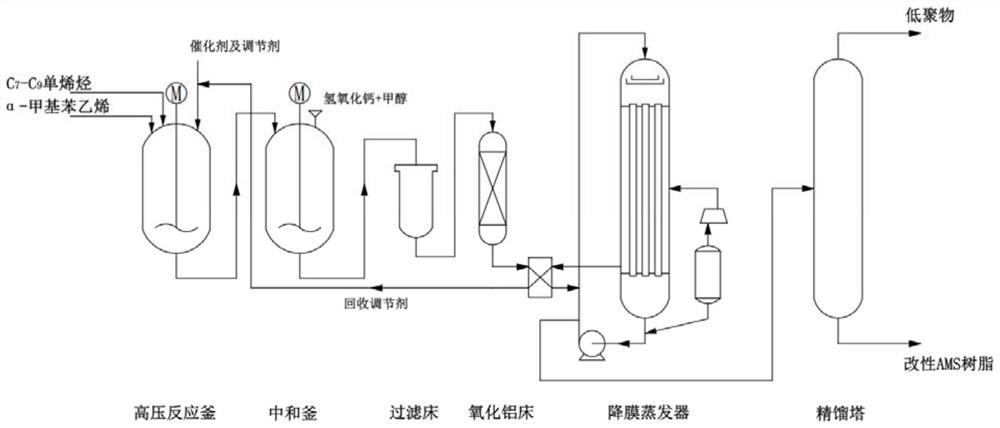Preparation method of flexible poly-alpha-methylstyrene resin
A technology of methyl styrene and styrene derivatives, applied in the field of petroleum resins, can solve the problems of uncontrollable rigid structural groups, too strong molecular rigidity, limited application range, etc., and achieve environmental protection and glass transition temperature The effect of low cost and simple technical process
- Summary
- Abstract
- Description
- Claims
- Application Information
AI Technical Summary
Problems solved by technology
Method used
Image
Examples
Embodiment 1
[0032] α-Methylstyrene and 2,3,3-trimethyl-1-butene are mixed as ingredients in a mass ratio of 1:0.25, and 55% of the total mass of the total material is put into a high-pressure reactor with stirring in advance. Hexanaphthene, then add the boron trifluoride that accounts for 0.2% of total material quality, and account for the 2,6-di-tert-butyl-4-methylpyridine of 3.03% of total material quality (with boron trifluoride mol ratio being 1 : 2), put into the mixed ingredients, the feeding time is 0.5h, and react at 10°C for 0.5h to obtain the polymerization liquid. Add 3.5% calcium hydroxide and 1.0% methanol to the polymerization solution to stop the reaction; first remove catalyst and other solid by-products through a 60-mesh bag filter bed, then remove residual insolubles with an alumina bed to obtain water White resinous liquid.
[0033] The above resin liquid is preheated to 55°C, transported to a falling film evaporator protected by nitrogen, at an operating pressure of 0...
Embodiment 2
[0035] α-Methylstyrene and 2,3,3-trimethyl-1-butene are mixed as ingredients in a mass ratio of 1:0.25, and 55% of the total mass of the total material is put into a high-pressure reactor with stirring in advance. Cyclohexane, then add boron trifluoride accounting for 0.2% of the total material quality, and nitrobenzene (1:2 with boron trifluoride molar ratio) accounting for 1.82% of the total material quality, drop into the mixed ingredients, and the feeding time is 0.5 h, and reacted at 10° C. for 0.5 h to obtain a polymerization solution. Add 3.5% calcium hydroxide and 1.0% methanol to the polymerization solution to stop the reaction; first remove catalyst and other solid by-products through a 60-mesh bag filter bed, then remove residual insolubles with an alumina bed to obtain water White resinous liquid.
[0036] The above resin liquid is preheated to 55°C, transported to a falling film evaporator protected by nitrogen, at an operating pressure of 0.03MPa, at a temperatu...
Embodiment 3~6
[0038] In Examples 3 to 6, cationic copolymerization was carried out with different ratios of α-methylstyrene (α-MS) and 2-methyl-1-octene (2M1O), and the rest of the conditions were the same as in Example 2.
[0039]
[0040]
[0041] Known from above-mentioned embodiment, along with the increase of 2-methyl-1-octene content in the proportioning raw material, the degree of polymerization index of modified poly-alpha-methylstyrene resin such as Mn changes little, and softening point and glass The melting temperature decreased significantly, that is, the flexibility of its molecular structure was strengthened, and the compatibility with metallocene polyolefin and other substrates was improved; due to the influence of aromatic and aliphatic copolymerization, the regularity of its molecular structure decreased, so the color index yellowness The index fell slightly.
PUM
| Property | Measurement | Unit |
|---|---|---|
| particle diameter | aaaaa | aaaaa |
| softening point | aaaaa | aaaaa |
| softening point | aaaaa | aaaaa |
Abstract
Description
Claims
Application Information
 Login to View More
Login to View More - R&D
- Intellectual Property
- Life Sciences
- Materials
- Tech Scout
- Unparalleled Data Quality
- Higher Quality Content
- 60% Fewer Hallucinations
Browse by: Latest US Patents, China's latest patents, Technical Efficacy Thesaurus, Application Domain, Technology Topic, Popular Technical Reports.
© 2025 PatSnap. All rights reserved.Legal|Privacy policy|Modern Slavery Act Transparency Statement|Sitemap|About US| Contact US: help@patsnap.com



